Consumer Decision Making Process: Behaviour, Insights & Marketing
VerifiedAdded on 2023/06/08
|13
|3284
|309
Report
AI Summary
This report provides a comprehensive analysis of consumer behaviour and the customer decision-making process, focusing on the various steps involved, including need identification, information search, evaluation, purchase decision, and post-purchase behaviour. It evaluates how marketers respond to this process, applying relevant concepts and models to influence customer buying patterns. The report highlights the importance of understanding consumer behaviour for marketers to map a path to purchase, gain a competitive advantage, and increase sales growth. It also compares and contrasts the key differences in the decision-making process between B2C and B2B contexts, emphasizing the factors that influence consumer buying behaviour, such as marketing research, product quality, and pricing. Furthermore, it evaluates various research approaches for understanding the decision-making process and how marketers can influence each stage, with reference to Kantar Group.
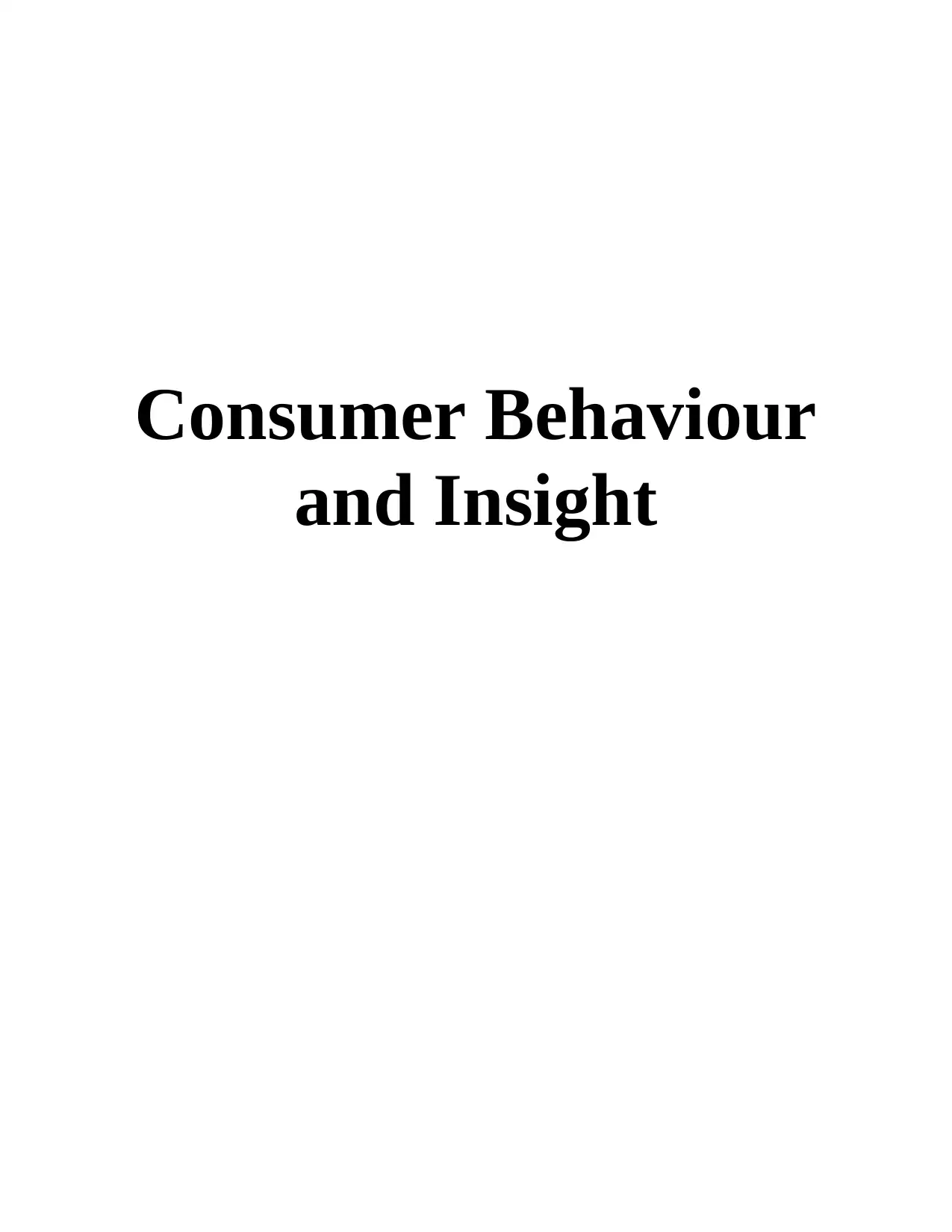
Consumer Behaviour
and Insight
and Insight
Paraphrase This Document
Need a fresh take? Get an instant paraphrase of this document with our AI Paraphraser
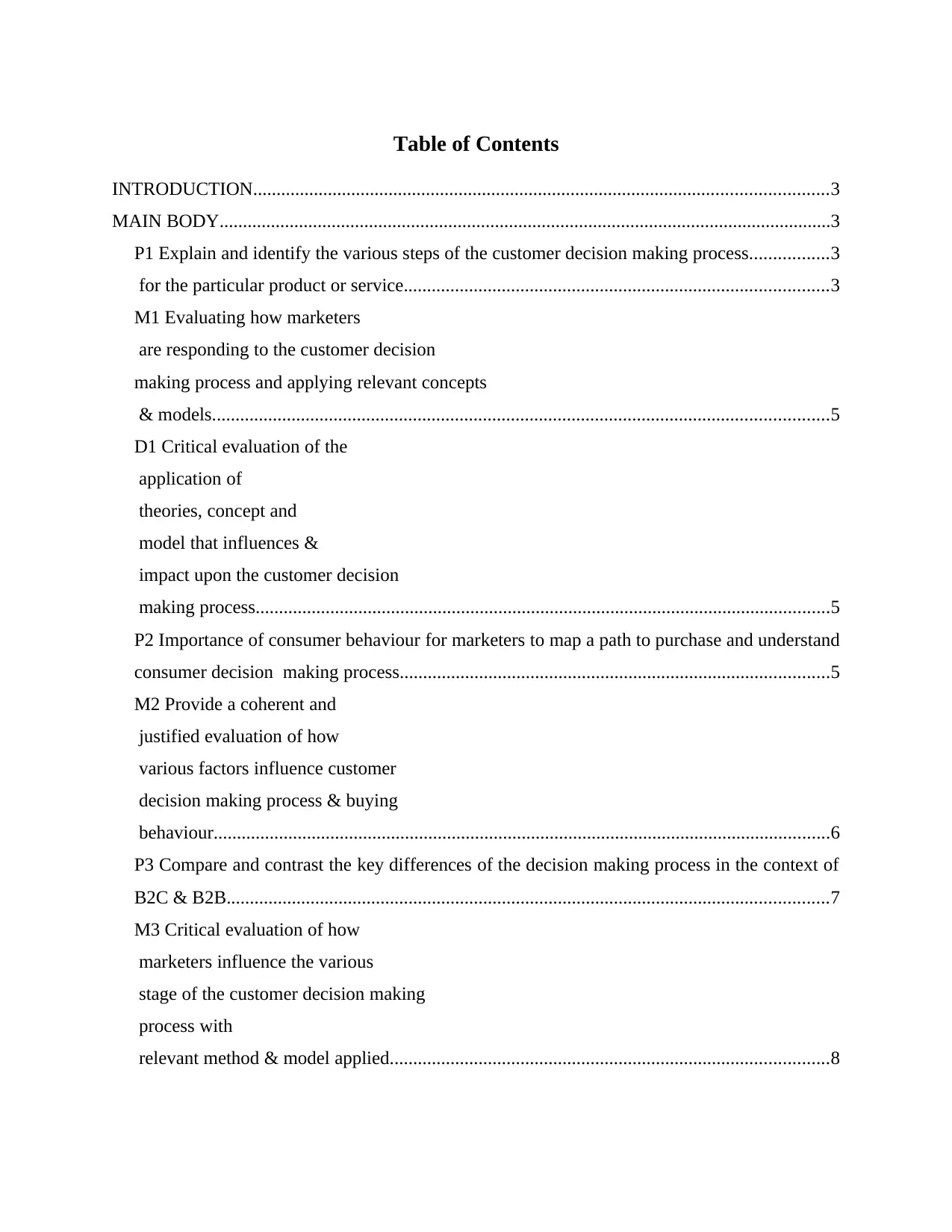
Table of Contents
INTRODUCTION...........................................................................................................................3
MAIN BODY...................................................................................................................................3
P1 Explain and identify the various steps of the customer decision making process.................3
for the particular product or service...........................................................................................3
M1 Evaluating how marketers
are responding to the customer decision
making process and applying relevant concepts
& models....................................................................................................................................5
D1 Critical evaluation of the
application of
theories, concept and
model that influences &
impact upon the customer decision
making process...........................................................................................................................5
P2 Importance of consumer behaviour for marketers to map a path to purchase and understand
consumer decision making process............................................................................................5
M2 Provide a coherent and
justified evaluation of how
various factors influence customer
decision making process & buying
behaviour....................................................................................................................................6
P3 Compare and contrast the key differences of the decision making process in the context of
B2C & B2B.................................................................................................................................7
M3 Critical evaluation of how
marketers influence the various
stage of the customer decision making
process with
relevant method & model applied..............................................................................................8
INTRODUCTION...........................................................................................................................3
MAIN BODY...................................................................................................................................3
P1 Explain and identify the various steps of the customer decision making process.................3
for the particular product or service...........................................................................................3
M1 Evaluating how marketers
are responding to the customer decision
making process and applying relevant concepts
& models....................................................................................................................................5
D1 Critical evaluation of the
application of
theories, concept and
model that influences &
impact upon the customer decision
making process...........................................................................................................................5
P2 Importance of consumer behaviour for marketers to map a path to purchase and understand
consumer decision making process............................................................................................5
M2 Provide a coherent and
justified evaluation of how
various factors influence customer
decision making process & buying
behaviour....................................................................................................................................6
P3 Compare and contrast the key differences of the decision making process in the context of
B2C & B2B.................................................................................................................................7
M3 Critical evaluation of how
marketers influence the various
stage of the customer decision making
process with
relevant method & model applied..............................................................................................8
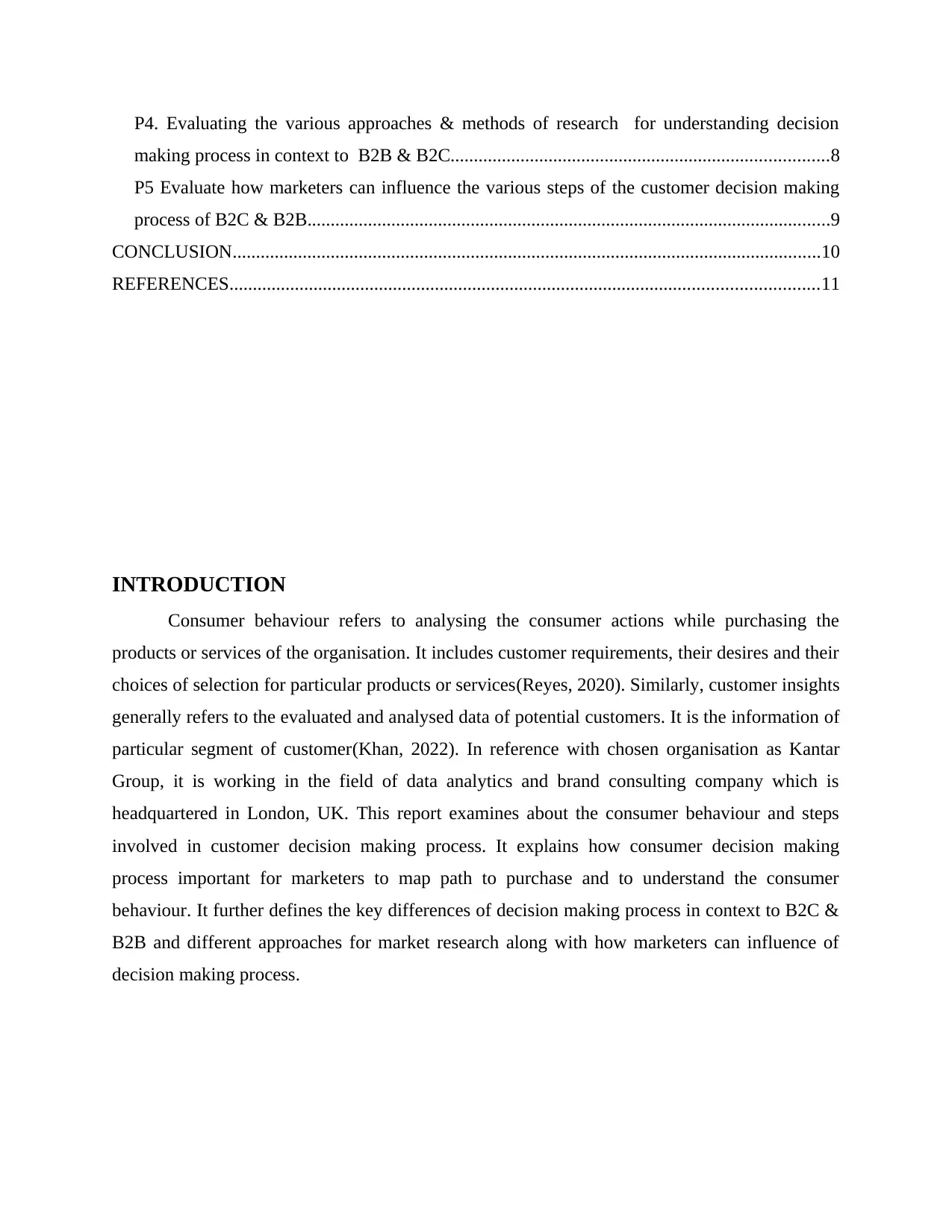
P4. Evaluating the various approaches & methods of research for understanding decision
making process in context to B2B & B2C.................................................................................8
P5 Evaluate how marketers can influence the various steps of the customer decision making
process of B2C & B2B................................................................................................................9
CONCLUSION..............................................................................................................................10
REFERENCES..............................................................................................................................11
INTRODUCTION
Consumer behaviour refers to analysing the consumer actions while purchasing the
products or services of the organisation. It includes customer requirements, their desires and their
choices of selection for particular products or services(Reyes, 2020). Similarly, customer insights
generally refers to the evaluated and analysed data of potential customers. It is the information of
particular segment of customer(Khan, 2022). In reference with chosen organisation as Kantar
Group, it is working in the field of data analytics and brand consulting company which is
headquartered in London, UK. This report examines about the consumer behaviour and steps
involved in customer decision making process. It explains how consumer decision making
process important for marketers to map path to purchase and to understand the consumer
behaviour. It further defines the key differences of decision making process in context to B2C &
B2B and different approaches for market research along with how marketers can influence of
decision making process.
making process in context to B2B & B2C.................................................................................8
P5 Evaluate how marketers can influence the various steps of the customer decision making
process of B2C & B2B................................................................................................................9
CONCLUSION..............................................................................................................................10
REFERENCES..............................................................................................................................11
INTRODUCTION
Consumer behaviour refers to analysing the consumer actions while purchasing the
products or services of the organisation. It includes customer requirements, their desires and their
choices of selection for particular products or services(Reyes, 2020). Similarly, customer insights
generally refers to the evaluated and analysed data of potential customers. It is the information of
particular segment of customer(Khan, 2022). In reference with chosen organisation as Kantar
Group, it is working in the field of data analytics and brand consulting company which is
headquartered in London, UK. This report examines about the consumer behaviour and steps
involved in customer decision making process. It explains how consumer decision making
process important for marketers to map path to purchase and to understand the consumer
behaviour. It further defines the key differences of decision making process in context to B2C &
B2B and different approaches for market research along with how marketers can influence of
decision making process.
⊘ This is a preview!⊘
Do you want full access?
Subscribe today to unlock all pages.

Trusted by 1+ million students worldwide
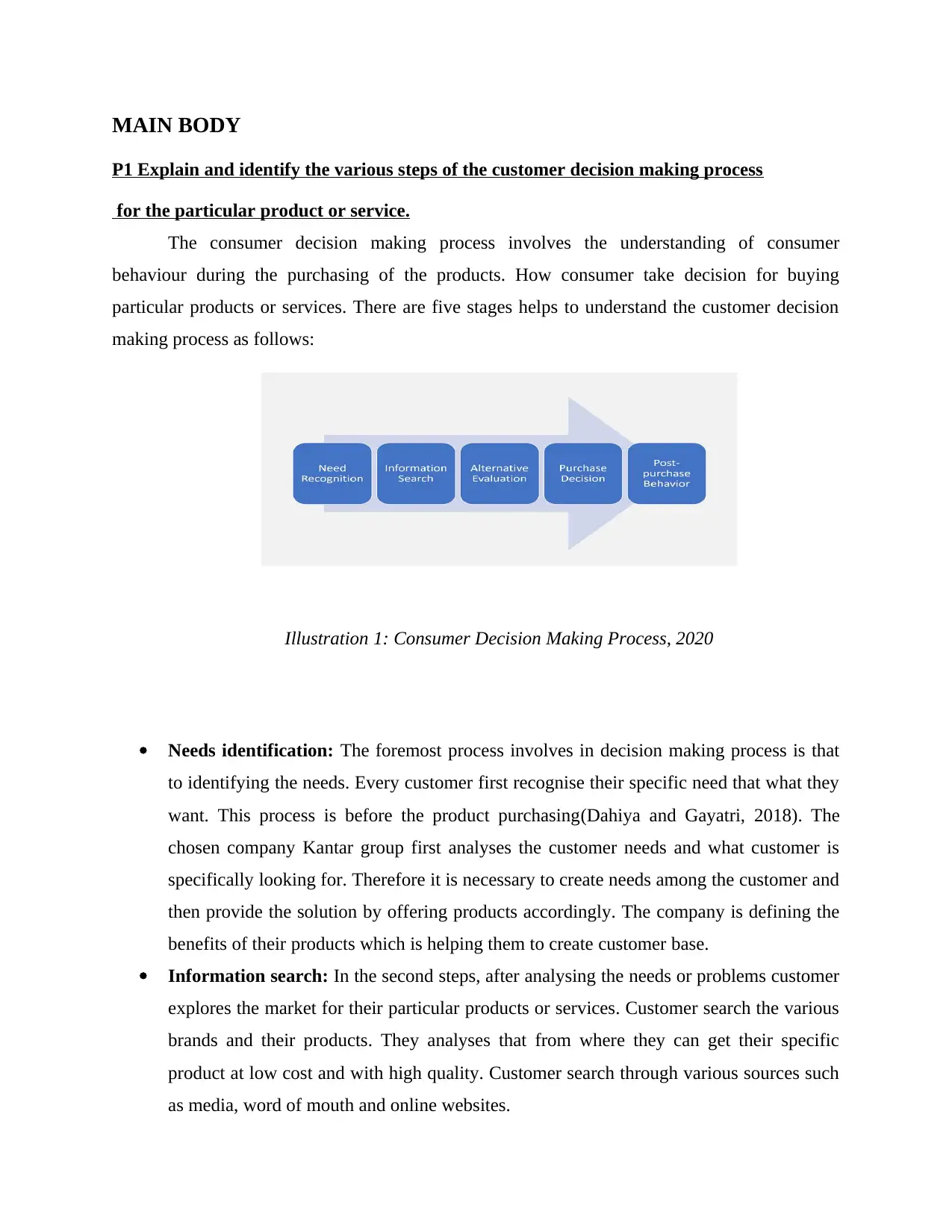
MAIN BODY
P1 Explain and identify the various steps of the customer decision making process
for the particular product or service.
The consumer decision making process involves the understanding of consumer
behaviour during the purchasing of the products. How consumer take decision for buying
particular products or services. There are five stages helps to understand the customer decision
making process as follows:
Needs identification: The foremost process involves in decision making process is that
to identifying the needs. Every customer first recognise their specific need that what they
want. This process is before the product purchasing(Dahiya and Gayatri, 2018). The
chosen company Kantar group first analyses the customer needs and what customer is
specifically looking for. Therefore it is necessary to create needs among the customer and
then provide the solution by offering products accordingly. The company is defining the
benefits of their products which is helping them to create customer base.
Information search: In the second steps, after analysing the needs or problems customer
explores the market for their particular products or services. Customer search the various
brands and their products. They analyses that from where they can get their specific
product at low cost and with high quality. Customer search through various sources such
as media, word of mouth and online websites.
Illustration 1: Consumer Decision Making Process, 2020
P1 Explain and identify the various steps of the customer decision making process
for the particular product or service.
The consumer decision making process involves the understanding of consumer
behaviour during the purchasing of the products. How consumer take decision for buying
particular products or services. There are five stages helps to understand the customer decision
making process as follows:
Needs identification: The foremost process involves in decision making process is that
to identifying the needs. Every customer first recognise their specific need that what they
want. This process is before the product purchasing(Dahiya and Gayatri, 2018). The
chosen company Kantar group first analyses the customer needs and what customer is
specifically looking for. Therefore it is necessary to create needs among the customer and
then provide the solution by offering products accordingly. The company is defining the
benefits of their products which is helping them to create customer base.
Information search: In the second steps, after analysing the needs or problems customer
explores the market for their particular products or services. Customer search the various
brands and their products. They analyses that from where they can get their specific
product at low cost and with high quality. Customer search through various sources such
as media, word of mouth and online websites.
Illustration 1: Consumer Decision Making Process, 2020
Paraphrase This Document
Need a fresh take? Get an instant paraphrase of this document with our AI Paraphraser
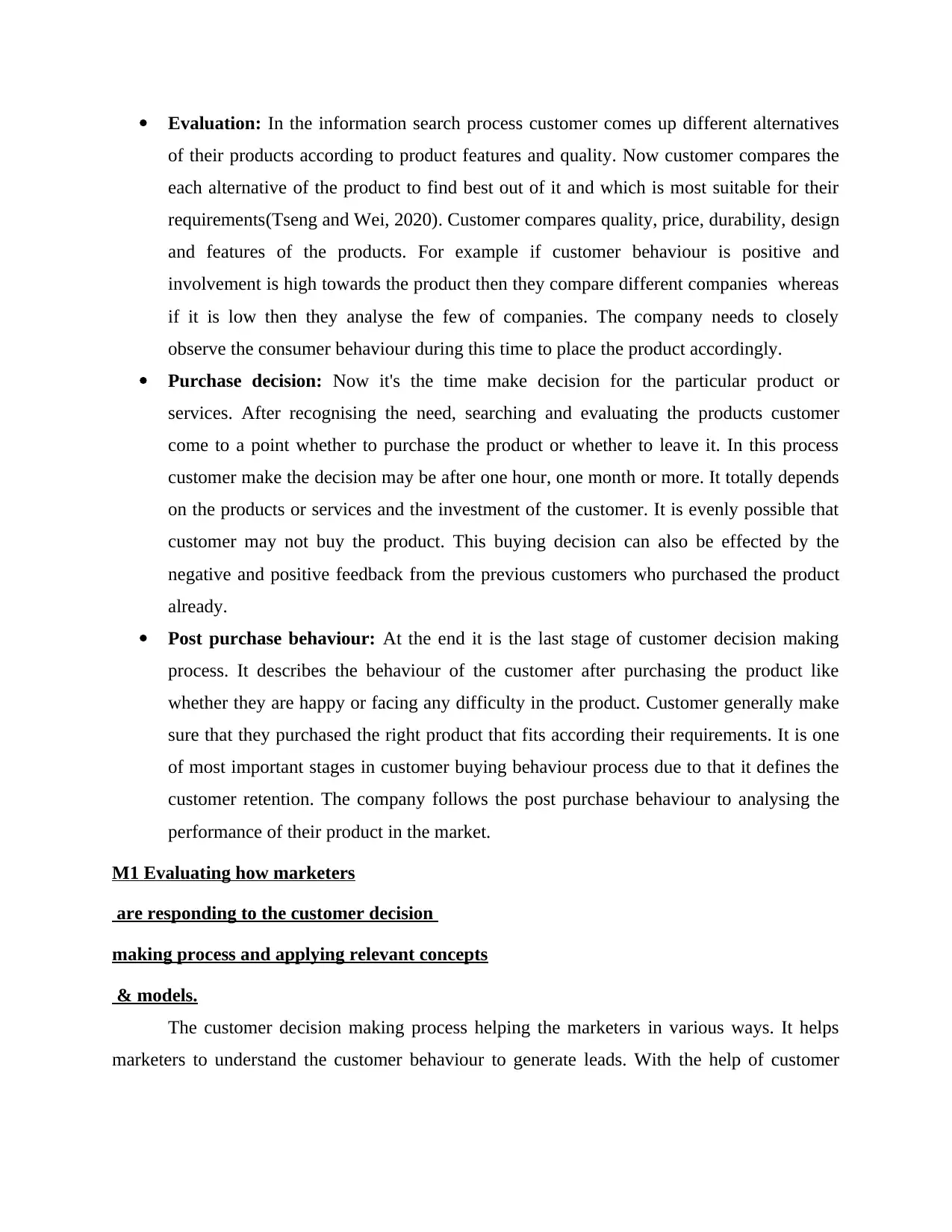
Evaluation: In the information search process customer comes up different alternatives
of their products according to product features and quality. Now customer compares the
each alternative of the product to find best out of it and which is most suitable for their
requirements(Tseng and Wei, 2020). Customer compares quality, price, durability, design
and features of the products. For example if customer behaviour is positive and
involvement is high towards the product then they compare different companies whereas
if it is low then they analyse the few of companies. The company needs to closely
observe the consumer behaviour during this time to place the product accordingly.
Purchase decision: Now it's the time make decision for the particular product or
services. After recognising the need, searching and evaluating the products customer
come to a point whether to purchase the product or whether to leave it. In this process
customer make the decision may be after one hour, one month or more. It totally depends
on the products or services and the investment of the customer. It is evenly possible that
customer may not buy the product. This buying decision can also be effected by the
negative and positive feedback from the previous customers who purchased the product
already.
Post purchase behaviour: At the end it is the last stage of customer decision making
process. It describes the behaviour of the customer after purchasing the product like
whether they are happy or facing any difficulty in the product. Customer generally make
sure that they purchased the right product that fits according their requirements. It is one
of most important stages in customer buying behaviour process due to that it defines the
customer retention. The company follows the post purchase behaviour to analysing the
performance of their product in the market.
M1 Evaluating how marketers
are responding to the customer decision
making process and applying relevant concepts
& models.
The customer decision making process helping the marketers in various ways. It helps
marketers to understand the customer behaviour to generate leads. With the help of customer
of their products according to product features and quality. Now customer compares the
each alternative of the product to find best out of it and which is most suitable for their
requirements(Tseng and Wei, 2020). Customer compares quality, price, durability, design
and features of the products. For example if customer behaviour is positive and
involvement is high towards the product then they compare different companies whereas
if it is low then they analyse the few of companies. The company needs to closely
observe the consumer behaviour during this time to place the product accordingly.
Purchase decision: Now it's the time make decision for the particular product or
services. After recognising the need, searching and evaluating the products customer
come to a point whether to purchase the product or whether to leave it. In this process
customer make the decision may be after one hour, one month or more. It totally depends
on the products or services and the investment of the customer. It is evenly possible that
customer may not buy the product. This buying decision can also be effected by the
negative and positive feedback from the previous customers who purchased the product
already.
Post purchase behaviour: At the end it is the last stage of customer decision making
process. It describes the behaviour of the customer after purchasing the product like
whether they are happy or facing any difficulty in the product. Customer generally make
sure that they purchased the right product that fits according their requirements. It is one
of most important stages in customer buying behaviour process due to that it defines the
customer retention. The company follows the post purchase behaviour to analysing the
performance of their product in the market.
M1 Evaluating how marketers
are responding to the customer decision
making process and applying relevant concepts
& models.
The customer decision making process helping the marketers in various ways. It helps
marketers to understand the customer behaviour to generate leads. With the help of customer
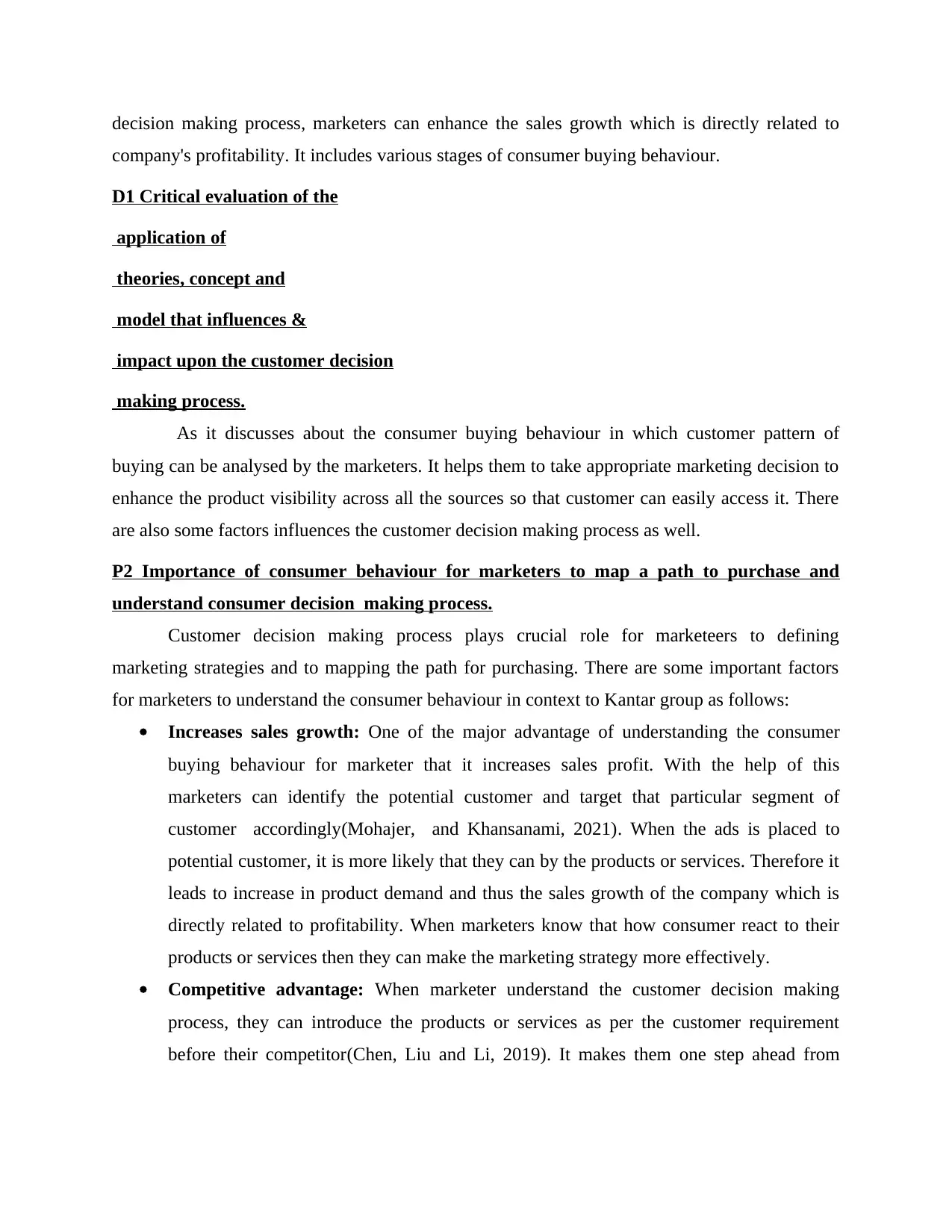
decision making process, marketers can enhance the sales growth which is directly related to
company's profitability. It includes various stages of consumer buying behaviour.
D1 Critical evaluation of the
application of
theories, concept and
model that influences &
impact upon the customer decision
making process.
As it discusses about the consumer buying behaviour in which customer pattern of
buying can be analysed by the marketers. It helps them to take appropriate marketing decision to
enhance the product visibility across all the sources so that customer can easily access it. There
are also some factors influences the customer decision making process as well.
P2 Importance of consumer behaviour for marketers to map a path to purchase and
understand consumer decision making process.
Customer decision making process plays crucial role for marketeers to defining
marketing strategies and to mapping the path for purchasing. There are some important factors
for marketers to understand the consumer behaviour in context to Kantar group as follows:
Increases sales growth: One of the major advantage of understanding the consumer
buying behaviour for marketer that it increases sales profit. With the help of this
marketers can identify the potential customer and target that particular segment of
customer accordingly(Mohajer, and Khansanami, 2021). When the ads is placed to
potential customer, it is more likely that they can by the products or services. Therefore it
leads to increase in product demand and thus the sales growth of the company which is
directly related to profitability. When marketers know that how consumer react to their
products or services then they can make the marketing strategy more effectively.
Competitive advantage: When marketer understand the customer decision making
process, they can introduce the products or services as per the customer requirement
before their competitor(Chen, Liu and Li, 2019). It makes them one step ahead from
company's profitability. It includes various stages of consumer buying behaviour.
D1 Critical evaluation of the
application of
theories, concept and
model that influences &
impact upon the customer decision
making process.
As it discusses about the consumer buying behaviour in which customer pattern of
buying can be analysed by the marketers. It helps them to take appropriate marketing decision to
enhance the product visibility across all the sources so that customer can easily access it. There
are also some factors influences the customer decision making process as well.
P2 Importance of consumer behaviour for marketers to map a path to purchase and
understand consumer decision making process.
Customer decision making process plays crucial role for marketeers to defining
marketing strategies and to mapping the path for purchasing. There are some important factors
for marketers to understand the consumer behaviour in context to Kantar group as follows:
Increases sales growth: One of the major advantage of understanding the consumer
buying behaviour for marketer that it increases sales profit. With the help of this
marketers can identify the potential customer and target that particular segment of
customer accordingly(Mohajer, and Khansanami, 2021). When the ads is placed to
potential customer, it is more likely that they can by the products or services. Therefore it
leads to increase in product demand and thus the sales growth of the company which is
directly related to profitability. When marketers know that how consumer react to their
products or services then they can make the marketing strategy more effectively.
Competitive advantage: When marketer understand the customer decision making
process, they can introduce the products or services as per the customer requirement
before their competitor(Chen, Liu and Li, 2019). It makes them one step ahead from
⊘ This is a preview!⊘
Do you want full access?
Subscribe today to unlock all pages.

Trusted by 1+ million students worldwide
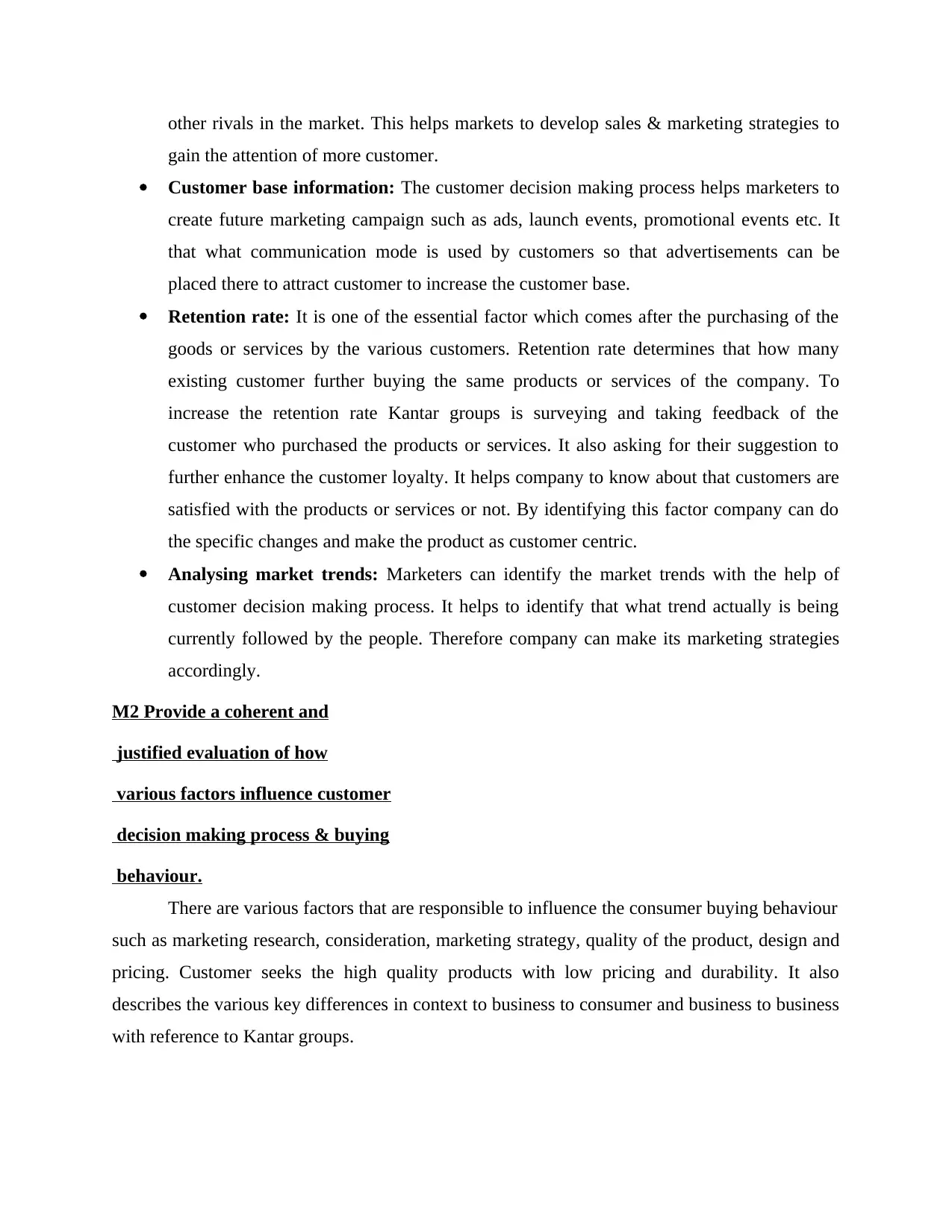
other rivals in the market. This helps markets to develop sales & marketing strategies to
gain the attention of more customer.
Customer base information: The customer decision making process helps marketers to
create future marketing campaign such as ads, launch events, promotional events etc. It
that what communication mode is used by customers so that advertisements can be
placed there to attract customer to increase the customer base.
Retention rate: It is one of the essential factor which comes after the purchasing of the
goods or services by the various customers. Retention rate determines that how many
existing customer further buying the same products or services of the company. To
increase the retention rate Kantar groups is surveying and taking feedback of the
customer who purchased the products or services. It also asking for their suggestion to
further enhance the customer loyalty. It helps company to know about that customers are
satisfied with the products or services or not. By identifying this factor company can do
the specific changes and make the product as customer centric.
Analysing market trends: Marketers can identify the market trends with the help of
customer decision making process. It helps to identify that what trend actually is being
currently followed by the people. Therefore company can make its marketing strategies
accordingly.
M2 Provide a coherent and
justified evaluation of how
various factors influence customer
decision making process & buying
behaviour.
There are various factors that are responsible to influence the consumer buying behaviour
such as marketing research, consideration, marketing strategy, quality of the product, design and
pricing. Customer seeks the high quality products with low pricing and durability. It also
describes the various key differences in context to business to consumer and business to business
with reference to Kantar groups.
gain the attention of more customer.
Customer base information: The customer decision making process helps marketers to
create future marketing campaign such as ads, launch events, promotional events etc. It
that what communication mode is used by customers so that advertisements can be
placed there to attract customer to increase the customer base.
Retention rate: It is one of the essential factor which comes after the purchasing of the
goods or services by the various customers. Retention rate determines that how many
existing customer further buying the same products or services of the company. To
increase the retention rate Kantar groups is surveying and taking feedback of the
customer who purchased the products or services. It also asking for their suggestion to
further enhance the customer loyalty. It helps company to know about that customers are
satisfied with the products or services or not. By identifying this factor company can do
the specific changes and make the product as customer centric.
Analysing market trends: Marketers can identify the market trends with the help of
customer decision making process. It helps to identify that what trend actually is being
currently followed by the people. Therefore company can make its marketing strategies
accordingly.
M2 Provide a coherent and
justified evaluation of how
various factors influence customer
decision making process & buying
behaviour.
There are various factors that are responsible to influence the consumer buying behaviour
such as marketing research, consideration, marketing strategy, quality of the product, design and
pricing. Customer seeks the high quality products with low pricing and durability. It also
describes the various key differences in context to business to consumer and business to business
with reference to Kantar groups.
Paraphrase This Document
Need a fresh take? Get an instant paraphrase of this document with our AI Paraphraser
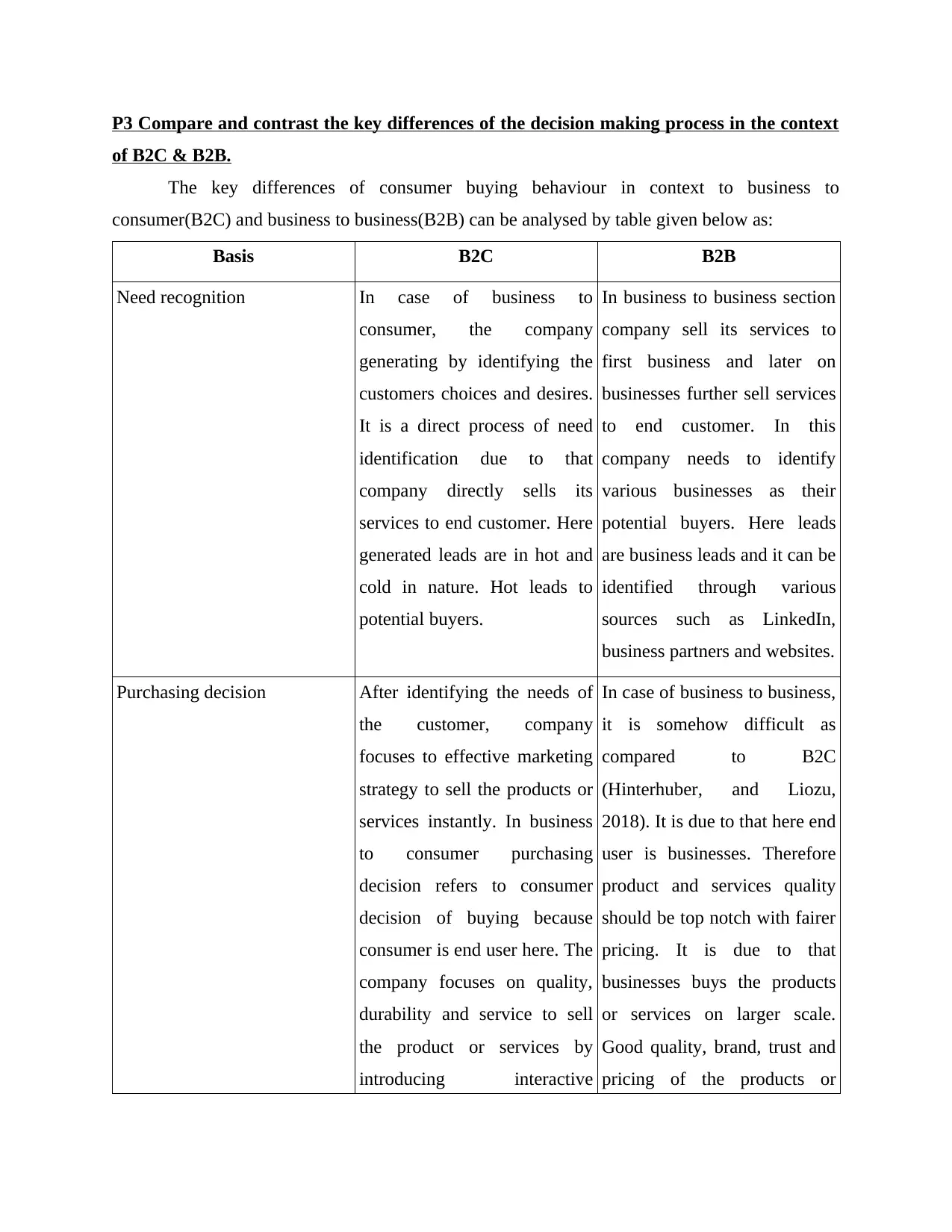
P3 Compare and contrast the key differences of the decision making process in the context
of B2C & B2B.
The key differences of consumer buying behaviour in context to business to
consumer(B2C) and business to business(B2B) can be analysed by table given below as:
Basis B2C B2B
Need recognition In case of business to
consumer, the company
generating by identifying the
customers choices and desires.
It is a direct process of need
identification due to that
company directly sells its
services to end customer. Here
generated leads are in hot and
cold in nature. Hot leads to
potential buyers.
In business to business section
company sell its services to
first business and later on
businesses further sell services
to end customer. In this
company needs to identify
various businesses as their
potential buyers. Here leads
are business leads and it can be
identified through various
sources such as LinkedIn,
business partners and websites.
Purchasing decision After identifying the needs of
the customer, company
focuses to effective marketing
strategy to sell the products or
services instantly. In business
to consumer purchasing
decision refers to consumer
decision of buying because
consumer is end user here. The
company focuses on quality,
durability and service to sell
the product or services by
introducing interactive
In case of business to business,
it is somehow difficult as
compared to B2C
(Hinterhuber, and Liozu,
2018). It is due to that here end
user is businesses. Therefore
product and services quality
should be top notch with fairer
pricing. It is due to that
businesses buys the products
or services on larger scale.
Good quality, brand, trust and
pricing of the products or
of B2C & B2B.
The key differences of consumer buying behaviour in context to business to
consumer(B2C) and business to business(B2B) can be analysed by table given below as:
Basis B2C B2B
Need recognition In case of business to
consumer, the company
generating by identifying the
customers choices and desires.
It is a direct process of need
identification due to that
company directly sells its
services to end customer. Here
generated leads are in hot and
cold in nature. Hot leads to
potential buyers.
In business to business section
company sell its services to
first business and later on
businesses further sell services
to end customer. In this
company needs to identify
various businesses as their
potential buyers. Here leads
are business leads and it can be
identified through various
sources such as LinkedIn,
business partners and websites.
Purchasing decision After identifying the needs of
the customer, company
focuses to effective marketing
strategy to sell the products or
services instantly. In business
to consumer purchasing
decision refers to consumer
decision of buying because
consumer is end user here. The
company focuses on quality,
durability and service to sell
the product or services by
introducing interactive
In case of business to business,
it is somehow difficult as
compared to B2C
(Hinterhuber, and Liozu,
2018). It is due to that here end
user is businesses. Therefore
product and services quality
should be top notch with fairer
pricing. It is due to that
businesses buys the products
or services on larger scale.
Good quality, brand, trust and
pricing of the products or
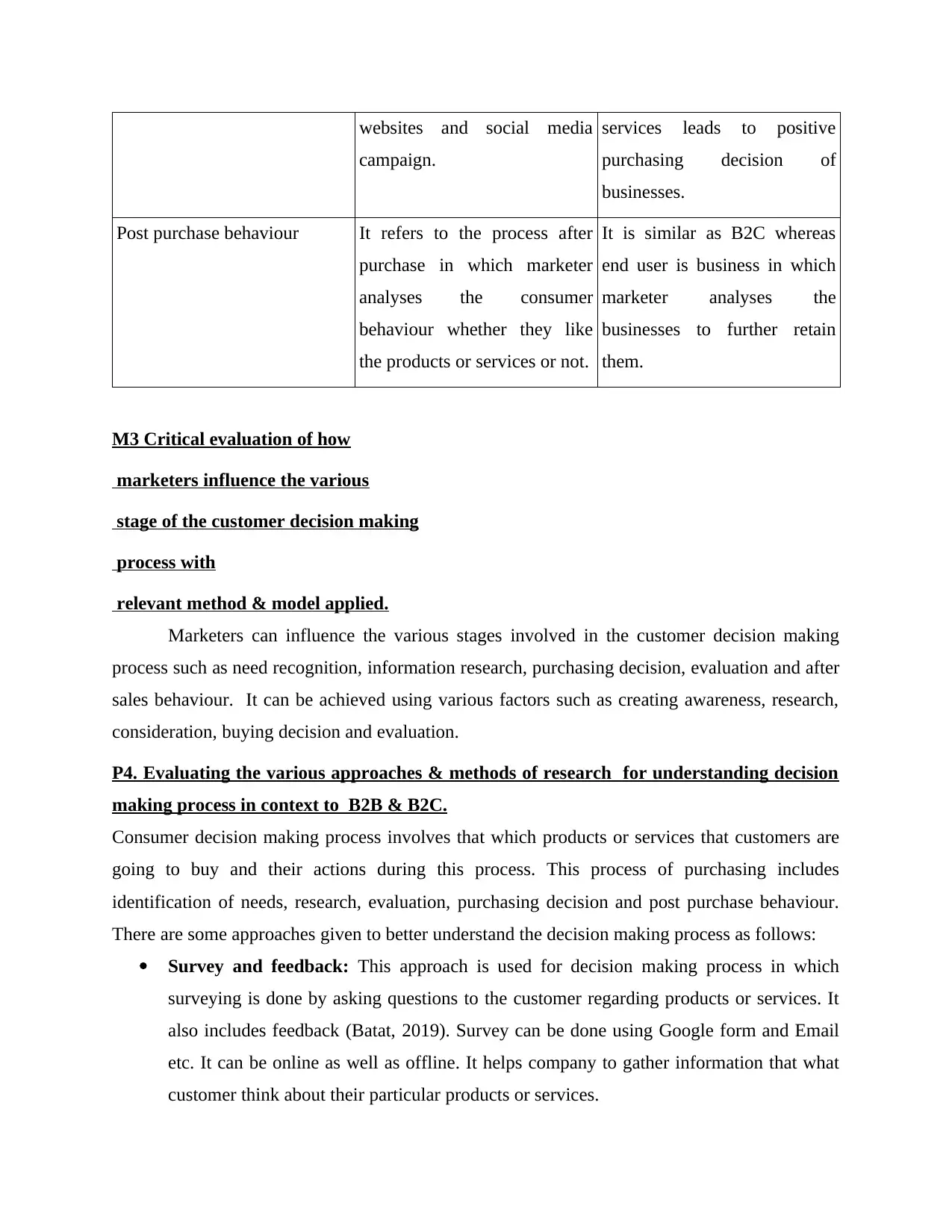
websites and social media
campaign.
services leads to positive
purchasing decision of
businesses.
Post purchase behaviour It refers to the process after
purchase in which marketer
analyses the consumer
behaviour whether they like
the products or services or not.
It is similar as B2C whereas
end user is business in which
marketer analyses the
businesses to further retain
them.
M3 Critical evaluation of how
marketers influence the various
stage of the customer decision making
process with
relevant method & model applied.
Marketers can influence the various stages involved in the customer decision making
process such as need recognition, information research, purchasing decision, evaluation and after
sales behaviour. It can be achieved using various factors such as creating awareness, research,
consideration, buying decision and evaluation.
P4. Evaluating the various approaches & methods of research for understanding decision
making process in context to B2B & B2C.
Consumer decision making process involves that which products or services that customers are
going to buy and their actions during this process. This process of purchasing includes
identification of needs, research, evaluation, purchasing decision and post purchase behaviour.
There are some approaches given to better understand the decision making process as follows:
Survey and feedback: This approach is used for decision making process in which
surveying is done by asking questions to the customer regarding products or services. It
also includes feedback (Batat, 2019). Survey can be done using Google form and Email
etc. It can be online as well as offline. It helps company to gather information that what
customer think about their particular products or services.
campaign.
services leads to positive
purchasing decision of
businesses.
Post purchase behaviour It refers to the process after
purchase in which marketer
analyses the consumer
behaviour whether they like
the products or services or not.
It is similar as B2C whereas
end user is business in which
marketer analyses the
businesses to further retain
them.
M3 Critical evaluation of how
marketers influence the various
stage of the customer decision making
process with
relevant method & model applied.
Marketers can influence the various stages involved in the customer decision making
process such as need recognition, information research, purchasing decision, evaluation and after
sales behaviour. It can be achieved using various factors such as creating awareness, research,
consideration, buying decision and evaluation.
P4. Evaluating the various approaches & methods of research for understanding decision
making process in context to B2B & B2C.
Consumer decision making process involves that which products or services that customers are
going to buy and their actions during this process. This process of purchasing includes
identification of needs, research, evaluation, purchasing decision and post purchase behaviour.
There are some approaches given to better understand the decision making process as follows:
Survey and feedback: This approach is used for decision making process in which
surveying is done by asking questions to the customer regarding products or services. It
also includes feedback (Batat, 2019). Survey can be done using Google form and Email
etc. It can be online as well as offline. It helps company to gather information that what
customer think about their particular products or services.
⊘ This is a preview!⊘
Do you want full access?
Subscribe today to unlock all pages.

Trusted by 1+ million students worldwide
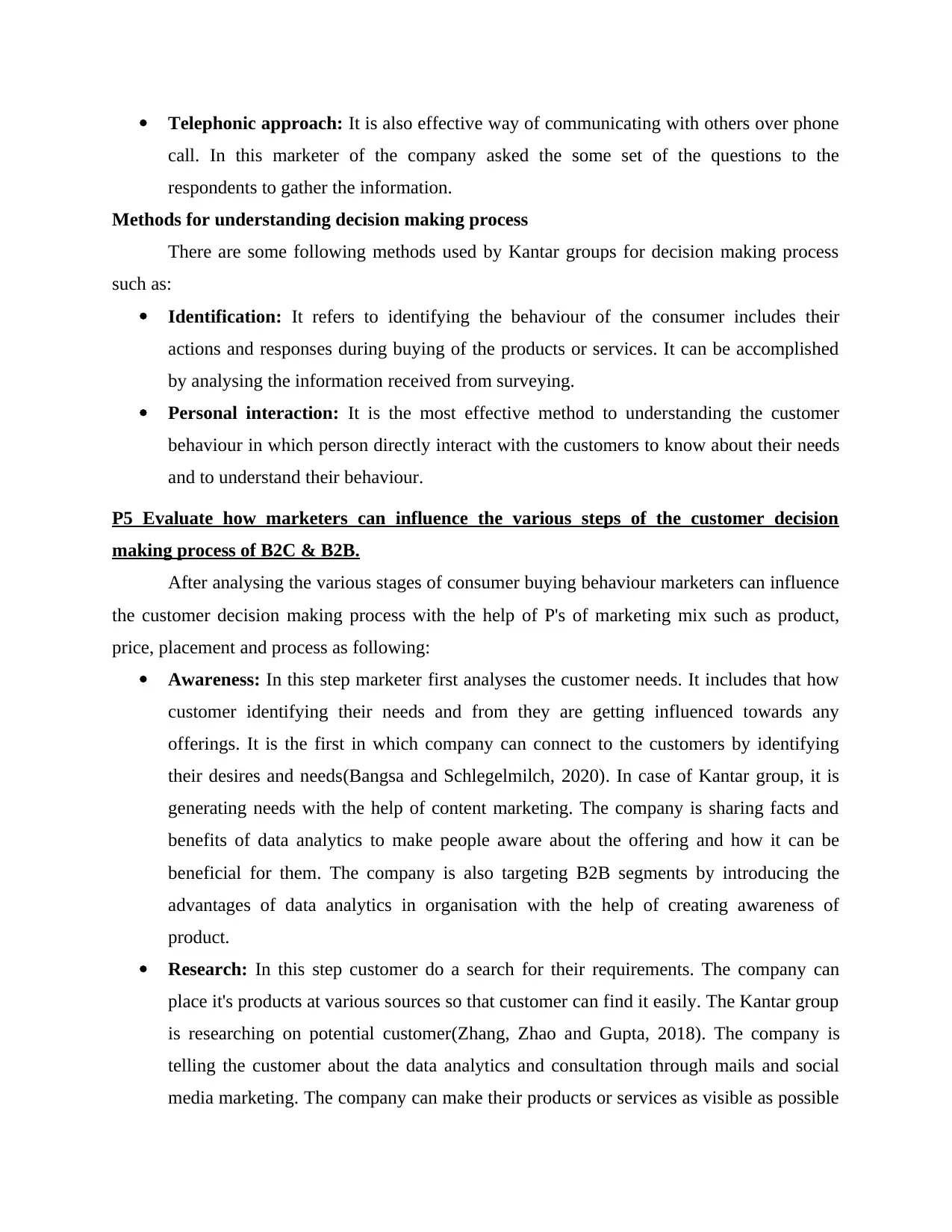
Telephonic approach: It is also effective way of communicating with others over phone
call. In this marketer of the company asked the some set of the questions to the
respondents to gather the information.
Methods for understanding decision making process
There are some following methods used by Kantar groups for decision making process
such as:
Identification: It refers to identifying the behaviour of the consumer includes their
actions and responses during buying of the products or services. It can be accomplished
by analysing the information received from surveying.
Personal interaction: It is the most effective method to understanding the customer
behaviour in which person directly interact with the customers to know about their needs
and to understand their behaviour.
P5 Evaluate how marketers can influence the various steps of the customer decision
making process of B2C & B2B.
After analysing the various stages of consumer buying behaviour marketers can influence
the customer decision making process with the help of P's of marketing mix such as product,
price, placement and process as following:
Awareness: In this step marketer first analyses the customer needs. It includes that how
customer identifying their needs and from they are getting influenced towards any
offerings. It is the first in which company can connect to the customers by identifying
their desires and needs(Bangsa and Schlegelmilch, 2020). In case of Kantar group, it is
generating needs with the help of content marketing. The company is sharing facts and
benefits of data analytics to make people aware about the offering and how it can be
beneficial for them. The company is also targeting B2B segments by introducing the
advantages of data analytics in organisation with the help of creating awareness of
product.
Research: In this step customer do a search for their requirements. The company can
place it's products at various sources so that customer can find it easily. The Kantar group
is researching on potential customer(Zhang, Zhao and Gupta, 2018). The company is
telling the customer about the data analytics and consultation through mails and social
media marketing. The company can make their products or services as visible as possible
call. In this marketer of the company asked the some set of the questions to the
respondents to gather the information.
Methods for understanding decision making process
There are some following methods used by Kantar groups for decision making process
such as:
Identification: It refers to identifying the behaviour of the consumer includes their
actions and responses during buying of the products or services. It can be accomplished
by analysing the information received from surveying.
Personal interaction: It is the most effective method to understanding the customer
behaviour in which person directly interact with the customers to know about their needs
and to understand their behaviour.
P5 Evaluate how marketers can influence the various steps of the customer decision
making process of B2C & B2B.
After analysing the various stages of consumer buying behaviour marketers can influence
the customer decision making process with the help of P's of marketing mix such as product,
price, placement and process as following:
Awareness: In this step marketer first analyses the customer needs. It includes that how
customer identifying their needs and from they are getting influenced towards any
offerings. It is the first in which company can connect to the customers by identifying
their desires and needs(Bangsa and Schlegelmilch, 2020). In case of Kantar group, it is
generating needs with the help of content marketing. The company is sharing facts and
benefits of data analytics to make people aware about the offering and how it can be
beneficial for them. The company is also targeting B2B segments by introducing the
advantages of data analytics in organisation with the help of creating awareness of
product.
Research: In this step customer do a search for their requirements. The company can
place it's products at various sources so that customer can find it easily. The Kantar group
is researching on potential customer(Zhang, Zhao and Gupta, 2018). The company is
telling the customer about the data analytics and consultation through mails and social
media marketing. The company can make their products or services as visible as possible
Paraphrase This Document
Need a fresh take? Get an instant paraphrase of this document with our AI Paraphraser
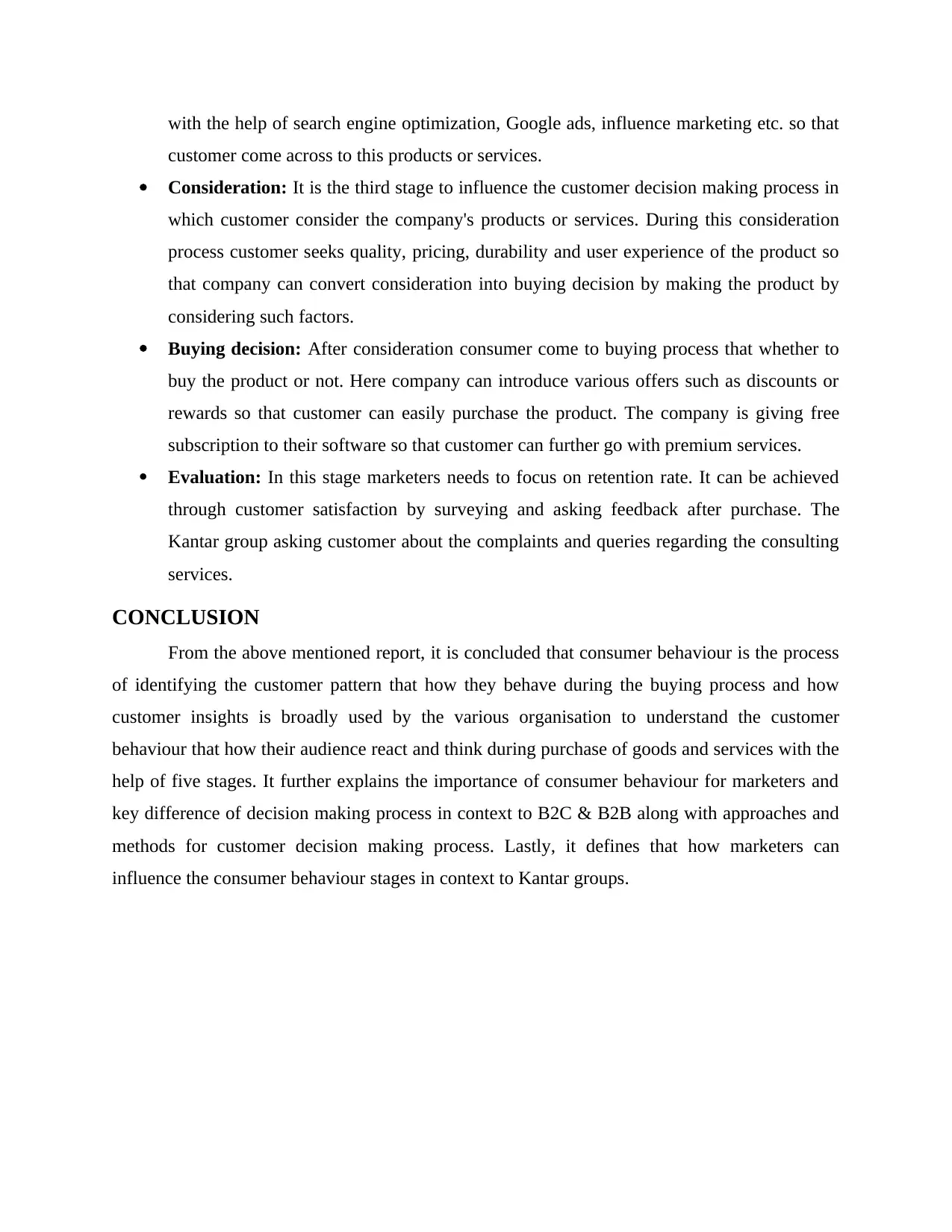
with the help of search engine optimization, Google ads, influence marketing etc. so that
customer come across to this products or services.
Consideration: It is the third stage to influence the customer decision making process in
which customer consider the company's products or services. During this consideration
process customer seeks quality, pricing, durability and user experience of the product so
that company can convert consideration into buying decision by making the product by
considering such factors.
Buying decision: After consideration consumer come to buying process that whether to
buy the product or not. Here company can introduce various offers such as discounts or
rewards so that customer can easily purchase the product. The company is giving free
subscription to their software so that customer can further go with premium services.
Evaluation: In this stage marketers needs to focus on retention rate. It can be achieved
through customer satisfaction by surveying and asking feedback after purchase. The
Kantar group asking customer about the complaints and queries regarding the consulting
services.
CONCLUSION
From the above mentioned report, it is concluded that consumer behaviour is the process
of identifying the customer pattern that how they behave during the buying process and how
customer insights is broadly used by the various organisation to understand the customer
behaviour that how their audience react and think during purchase of goods and services with the
help of five stages. It further explains the importance of consumer behaviour for marketers and
key difference of decision making process in context to B2C & B2B along with approaches and
methods for customer decision making process. Lastly, it defines that how marketers can
influence the consumer behaviour stages in context to Kantar groups.
customer come across to this products or services.
Consideration: It is the third stage to influence the customer decision making process in
which customer consider the company's products or services. During this consideration
process customer seeks quality, pricing, durability and user experience of the product so
that company can convert consideration into buying decision by making the product by
considering such factors.
Buying decision: After consideration consumer come to buying process that whether to
buy the product or not. Here company can introduce various offers such as discounts or
rewards so that customer can easily purchase the product. The company is giving free
subscription to their software so that customer can further go with premium services.
Evaluation: In this stage marketers needs to focus on retention rate. It can be achieved
through customer satisfaction by surveying and asking feedback after purchase. The
Kantar group asking customer about the complaints and queries regarding the consulting
services.
CONCLUSION
From the above mentioned report, it is concluded that consumer behaviour is the process
of identifying the customer pattern that how they behave during the buying process and how
customer insights is broadly used by the various organisation to understand the customer
behaviour that how their audience react and think during purchase of goods and services with the
help of five stages. It further explains the importance of consumer behaviour for marketers and
key difference of decision making process in context to B2C & B2B along with approaches and
methods for customer decision making process. Lastly, it defines that how marketers can
influence the consumer behaviour stages in context to Kantar groups.

⊘ This is a preview!⊘
Do you want full access?
Subscribe today to unlock all pages.

Trusted by 1+ million students worldwide
1 out of 13
Related Documents
Your All-in-One AI-Powered Toolkit for Academic Success.
+13062052269
info@desklib.com
Available 24*7 on WhatsApp / Email
![[object Object]](/_next/static/media/star-bottom.7253800d.svg)
Unlock your academic potential
Copyright © 2020–2025 A2Z Services. All Rights Reserved. Developed and managed by ZUCOL.



